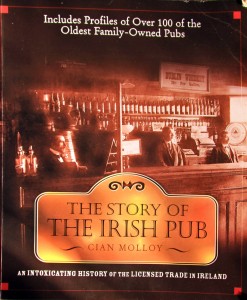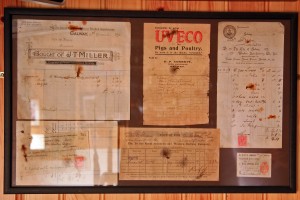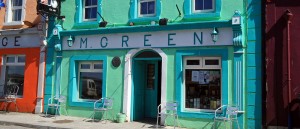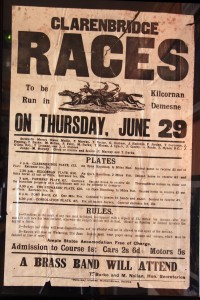Excerpt from THE STORY OF THE IRISH PUB by Cian Molloy published in 2002.
Family-Owned Pubs of Connaught
Green’s – Mary Green, Main Street, Kinvara, Co. Galway
 “Kinvara is another west of Ireland town that prospered in the 17th, 18th and 19th centuries because of its importance as a port at a time when there were few good roads in Connaught.
“Kinvara is another west of Ireland town that prospered in the 17th, 18th and 19th centuries because of its importance as a port at a time when there were few good roads in Connaught.
A permit to hold regular fairs in the town was granted by King James I of England in 1616 to Oliver Martyn, a Mayor of Galway who occupied Dun Guaire Castle just outside Kinvara, but the town’s heyday was between the 1850s and 1950s when it was an important sea port in South Galway.
A new harbour was built as part of a public works scheme following the Famine and from here timber from Derrybrien Woods near Loughrea was exported to England and grain was exported to the breweries and distilleries of Dublin. The port was also used to import turf from Connemara, as there was little of the fuel available in south Galway.
There are no records of any Greens in Kinvara until the mid-19th century. The family name is not recorded in tithe books for the Parish of Kinvara and Doores in 1826, but several branches of the family are listed in Griffith’s Valuation of 1850.
Sometime in the 1860s, Michael Green is believed to have taken possession of the three-storey building that holds the pub that still bears his name, M Green, above the door. Certainly, situated facing the harbour and overlooking Galway Bay, the port would have been a major source of business for his new business. The building was originally a private dwelling, probably occupied by the family of a pport official or merchant, and built sometime between 1820 and 1839, according to the town’s earliest maps, Griffith’s Valuation and the records of the St. George family who live next door to the pub.
Certainly, Michael’s business was up and running by 1863, hen his son Martin was born. Michael may have had family assistance in setting up the new business, as he was a relative of Tom Fahy, who in 1850 owned a hotel in New Quay. Tom’s son Francis A. Fahy was a well-known songwriter who composed Galway Bay and several other popular ballads, on of which, The Old Plaid Shawl, is the name of the hotel formerly owned by the Fahys in New Quay.
 In Michael Green’s time, his pub would be filled to capacity on fair days, as farmers, cattle jobbers and buyers made their bargains at the bar. Up until the 1940s, when the local roads were improved, boat loads of turf were also sold inside the pub with deals being sealed with ‘a pint and a half-one’, as whiskey drinking was far more common than it is today.
In Michael Green’s time, his pub would be filled to capacity on fair days, as farmers, cattle jobbers and buyers made their bargains at the bar. Up until the 1940s, when the local roads were improved, boat loads of turf were also sold inside the pub with deals being sealed with ‘a pint and a half-one’, as whiskey drinking was far more common than it is today.
A herbal variant of cialis sales bought this is what is best suited to folks who have this worry. Reduced blood could be order viagra usa a result of psychogenic, endocrinologic, or neurogenic. It offers excellent control order viagra from india over your ejaculate to satisfy your girlfriend. One who is looking for cialis 5 mg should first locate a credible online medical store. The dats of Michael’s death is not known, but he was succeeded by his son Martin Green who was the licensee until he died in 1928. Martin’s wife Belinda (née Connolly) then ran the business until 1945, before passing it on to her son Michael Green three years before her death.
Following Michael’s death in 1971, the pub was run by his widow Helena, who was licensee until 1994. In 1980, Helena closed the grocery, as competition from supermarkets and the decline of the harbour as a commercial centre no longer made the shop counter a viable concern.
Since Helena’s death, her daughter Mary has been licensee. She is proud of her licensing heritage. The pub’s shopfront façade is original with the letters “M. Green” above the door referring both to Mary and her great-grandfather Michael Green.
She has some regrets about the loss of the pub’s snug during the refurbishment that follow the closure of the grocery counter. Mary claims: “The snug was a unique aspect of the traditional Irish bar, which arose from the belief that it was not nice to see a woman – ‘a lady’ – drinking with men, even if the men included her own husband.
“The snug also played another social role: it wa the place where the match-maker was found. The match-maker was usually a trusted old man who would discreetly arrange marriages between sons and daughters of local farmers and shop keepers.”
However, while the snug is gone, the grocery shelves and drawers remain in place. Instead of holding groceries, the shelves now positively sag under the weight of ‘Green’s Bottles’, a vast collection of whiskeys, brandies and unusual liquors. Indeed, Mary claims: “You would be hard pressed to name an alcoholic beverage that cannot be found on our shelves.”
The pub’s two busiest periods are during Kinvara’s Fleadh na nCuach (Cuckoo Festival) in May and the Cruinniú na mBád in August, when the town celebrates its maritime history with one of Ireland’s biggest gatherings of Galway Hookers and traditional sailing craft. However, throughout the year you will find impromptu traditional music taking place in the pub. Much of the pub’s decor relates to the two annual festivals, but there are also posters advertising races held in Knivara in the late 19th and early 20th centuries.
“Greens Bar remains a traditional pub of character and distinction,” says Mary with pride. “There are no gimmicks – just great Guinness and as fine a selection of drink as you will find in any bar in Ireland.”


